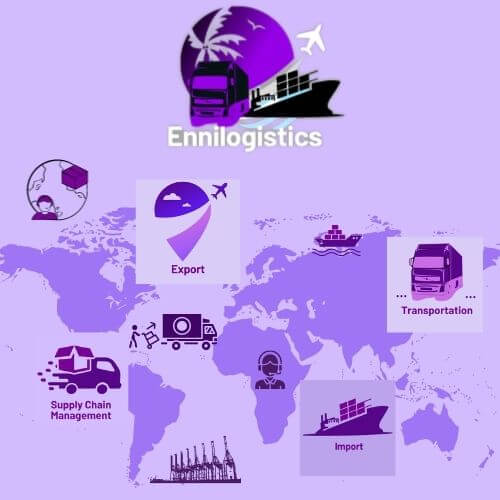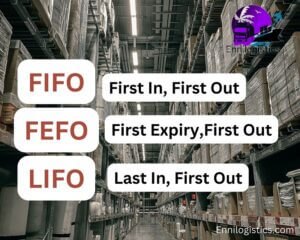There is no way to overstate how important effective supply chain management is in today’s fast-paced business environment. Any company that works in the logistics sector relies on it as a pillar of success and profitability.
A streamlined supply chain ensures that the flow of goods, information, and resources moves seamlessly from the point of origin to the end consumer. Process optimization, waste reduction, and increased general efficiency can help businesses gain a competitive edge and deliver exceptional customer experiences.
The benefits of effective supply chain management are numerous. They primarily support cost savings by enhancing inventory control and reducing lead times. Businesses can maintain ideal stock levels and reduce the risk of excess inventory or stockouts by accurately forecasting demand. As a result, holding costs are decreased, cash flow is improved, and the bottom line is ultimately increased.
Additionally, a streamlined supply chain leads to increased customer satisfaction. Businesses can deliver goods on time, with shorter lead times, and with the appropriate stock levels by streamlining coordination and processing orders more quickly. Increased customer retention, positive word-of-mouth, and a strong brand reputation are the results.
Efficiency in supply chain management also promotes flexibility and responsiveness. Businesses can quickly respond to market demands and customer needs by having a well-coordinated network of suppliers, manufacturers, and distributors. This adaptability guarantees the capacity to take advantage of opportunities and successfully navigate difficulties, maintaining a competitive advantage in the market.
Also, a streamlined supply chain contributes to sustainability efforts. By optimizing transportation routes, reducing carbon emissions, and minimizing waste throughout the supply chain, businesses can align with environmental goals and support a greener future.
In this blog post, we will explore the five best practices to help you achieve a streamlined supply chain. we will delve into actionable strategies that can revolutionize your logistics operations.
So, join us as we uncover the key to unlocking operational efficiency, cost savings, and customer satisfaction through effective supply chain management. Let’s embark on this journey together and discover how a streamlined supply chain can drive success in the ever-evolving world of logistics.

01. Accurate Demand forecasting
By understanding and predicting customer demand patterns, businesses can make informed decisions, optimize inventory levels, and ensure smooth operations throughout the supply chain.
Accurate demand forecasting helps businesses anticipate market trends, seasonal variations, and shifts in consumer preferences. It provides valuable insights into which products are likely to experience high demand and when. Armed with this knowledge, businesses can align their procurement, production, and distribution processes accordingly, avoiding both excess inventory and stockouts.
Furthermore, demand forecasting enables businesses to optimize their inventory management practices. By knowing the expected demand for specific products or product categories, businesses can maintain optimal stock levels, reducing storage costs and avoiding overstocking situations that tie up valuable capital. This, in turn, leads to improved cash flow and better resource allocation.
To achieve accurate demand forecasting, businesses employ various methods and leverage advanced tools. These methods include analyzing historical sales data, conducting market research, and incorporating customer feedback. By combining these approaches, businesses can develop more robust and reliable demand forecasts.
Additionally, businesses can leverage technological tools to enhance their demand forecasting capabilities. Advanced statistical models, machine learning algorithms, and predictive analytics software can process vast amounts of data and identify underlying patterns and trends. These tools enable businesses to generate more accurate and precise demand forecasts, supporting decision-making processes.
The impact of demand forecasting on supply chain efficiency is significant. It will help you strengthen your relationships with suppliers and get rid of extra inventory.
02. Supplier Relationship Management
In the realm of supply chain management, strong supplier relationships are the foundation of a well-functioning and efficient supply chain. Cultivating and nurturing these relationships can bring numerous benefits to businesses, including improved reliability, enhanced collaboration, and a competitive edge in the marketplace.
When businesses establish strong supplier relationships, they build a sense of trust and mutual understanding. This fosters open communication channels and enables both parties to align their goals and objectives. By working closely together, businesses and suppliers can respond quickly to market changes, address challenges proactively, and seize opportunities for mutual growth.
To foster and maintain effective supplier relationships, businesses can employ these key strategies:
- Clear communication
- Establishing mutual goals
- Collaboration and innovation
- Performance measurement and feedback
- Long-term partnerships
By prioritizing effective supplier relationship management, businesses can establish a robust and reliable supply chain network, strengthen their market position, and ultimately deliver superior value to their customers.
03. Efficient Warehouse Management
When it comes to supply chain management, streamlined warehouse operations are at the heart of efficient logistics. An effectively managed warehouse ensures the smooth and timely movement of goods, maximizes space utilization, and minimizes operational costs. It serves as a crucial link between suppliers and customers, playing a vital role in meeting customer demands and maintaining a competitive edge.
Streamlined warehouse operations offer several benefits. They enable businesses to reduce order processing times, leading to faster order fulfillment and improved customer satisfaction. With optimized processes in place, businesses can minimize errors, accurately pick and pack orders, and ensure timely dispatch.
Warehouse layout optimization plays a critical role in maximizing space utilization and operational efficiency. By strategically designing the layout, businesses can minimize travel distances, reduce congestion, and enhance overall productivity. Some key techniques for warehouse layout optimization include,
- Slotting: Assigning the most frequently picked items closer to the packing and shipping areas to minimize travel time.
- Zoning: Dividing the warehouse into dedicated zones based on product types, sizes, or storage requirements to streamline the picking and stocking processes.
- ABC Analysis: Categorizing products based on their demand patterns and assigning them to specific storage locations accordingly. This ensures easy access to high-demand items while optimizing space for slower-moving products.
In the digital age, technological advancements have revolutionized warehouse management practices. Leveraging these technologies can greatly enhance inventory tracking and order fulfillment processes. Here are some of the most highly rated technologies.
- Warehouse Management Systems (WMS): These software solutions automate and optimize warehouse operations by providing real-time visibility into inventory levels, managing order processing, and generating performance analytics.
- Barcode and RFID Systems: Barcoding and RFID (Radio Frequency Identification) technologies enable accurate and efficient inventory tracking. They help streamline receiving, put-away, picking, and shipping processes, reducing errors and improving overall operational efficiency.
- Automated Storage and Retrieval Systems (AS/RS): These systems use robotics and automation to handle storage, retrieval, and movement of inventory. They improve order accuracy, reduce labor costs, and maximize space utilization.
By embracing these technologies, businesses can achieve greater efficiency in inventory tracking, order fulfillment, and overall warehouse management, resulting in improved customer satisfaction and increased operational effectiveness.
Efficient warehouse management is a cornerstone of a streamlined supply chain. By optimizing warehouse operations, businesses can enhance productivity, reduce costs, and meet customer expectations with speed and accuracy.
04. Collaboration and Information Sharing
In today’s interconnected business landscape, collaboration among supply chain stakeholders has become paramount. Effective collaboration enables businesses to align their goals, share knowledge, and collectively work towards streamlining the entire supply chain. By fostering strong relationships and open communication, businesses can achieve greater efficiency, and responsiveness, and ultimately deliver superior value to their customers.
Collaboration among supply chain stakeholders brings numerous benefits. It enables improved demand forecasting accuracy, as suppliers, manufacturers, and distributors can share vital market insights and customer feedback. This collaborative approach ensures that supply chain operations are well-aligned with market demands, minimizing inventory holding costs and optimizing production schedules.
Moreover, collaboration fosters better risk management. By sharing information on potential disruptions or market changes, supply chain stakeholders can collectively develop contingency plans, mitigating risks and minimizing the impact on operations. This proactive approach enhances the resilience and adaptability of the entire supply chain network
Effective collaboration heavily relies on seamless communication and information sharing. Businesses can use a variety of communication tools and strategies to help with this such as,
- Collaborative platforms: Utilizing digital collaboration platforms and project management tools allows stakeholders to collaborate in real-time, share documents, track progress, and communicate efficiently across different locations.
- Regular meetings and conferences: Conducting regular meetings, both virtual and in-person, brings stakeholders together to discuss strategies, resolve issues, and foster strong relationships. These meetings provide an opportunity for open dialogue and brainstorming sessions.
- Shared data repositories: Implementing shared data repositories or cloud-based systems enables stakeholders to access and update information in a centralized and secure manner. This promotes transparency, facilitates data-driven decision-making, and reduces the risk of information silos.
The pharmaceutical sector is the best example of the transformative power of information sharing and collaboration. Pharmaceutical companies collaborate with healthcare providers and distributors to share data on inventory levels, production capacities, and demand trends. This collaboration ensures the timely availability of medications, reduces shortages, and improves patient care.
05. Continuous Improvement and Performance Measurement
In the dynamic world of supply chain management, continuous improvement is essential for businesses to stay competitive and meet evolving customer expectations. By striving for ongoing enhancements in processes, technologies, and strategies, businesses can achieve greater efficiency, cost savings, and customer satisfaction.
Continuous improvement fosters a culture of innovation and adaptability within the supply chain. It encourages stakeholders to identify inefficiencies, eliminate waste, and implement best practices. Through a proactive approach to improvement, businesses can optimize their operations, enhance productivity, and drive sustainable growth.
Performance measurement is a crucial aspect of continuous improvement in supply chain operations. By defining key performance indicators (KPIs) and implementing appropriate measurement techniques, businesses can track their progress, identify areas for improvement, and make data-driven decisions. Some commonly used performance measurement techniques and KPIs include:
- On-time Delivery: Measuring the percentage of orders delivered on time indicating the reliability and efficiency of the supply chain in meeting customer expectations.
- Order Accuracy: Tracking the accuracy of order fulfillment, measuring the frequency of errors and customer returns, and striving for error-free operations.
- Inventory Turnover: Calculating the rate at which inventory is sold and replenished, aiming to optimize inventory levels, reduce carrying costs, and prevent stockouts.
- Supplier Performance: Assessing supplier performance based on metrics such as on-time delivery, product quality, and responsiveness ensures strong and reliable supplier relationships.
Numerous companies have achieved significant improvements by embracing continuous improvement and effective performance measurement in their supply chain operations. Amazon and Toyta are key examples of that.
Amazon is known for its relentless pursuit of operational excellence. Amazon continually refines its supply chain processes to enhance speed and customer satisfaction. Through continuous improvement initiatives and performance measurement, Amazon has streamlined its order fulfillment, optimized inventory management, and set new industry standards for efficient logistics.
On the other hand, Toyota’s renowned Toyota Production System (TPS) focuses on continuous improvement and waste reduction. By implementing performance measurement techniques like just-in-time (JIT) inventory management and Total Quality Management (TQM), Toyota has achieved exceptional operational efficiency and quality standards throughout its supply chain.
Best Practices for Streamlined Supply Chain Management” holds the promise of transforming businesses’ logistics operations and positioning them for success in a rapidly evolving marketplace. By embracing the principles discussed throughout this article and adopting a collaborative, data-driven, and continuous improvement mindset, businesses can unlock the true potential of their supply chains.
From accurate demand forecasting and efficient warehouse management to collaboration and information sharing, every aspect of supply chain management plays a crucial role in streamlining operations and achieving superior outcomes. By recognizing the significance of these best practices and implementing them with dedication and enthusiasm, businesses can reap a multitude of benefits.
The journey toward a streamlined supply chain may require dedication, effort, and continuous learning, but the rewards are well worth it. By prioritizing efficiency, innovation, and customer-centricity, businesses can position themselves as leaders in their industries and deliver outstanding value to their customers.
Remember, the power to streamline your supply chain lies in your hands. Embrace these best practices, empower your teams, and unlock the full potential of your supply chain operations.
You may like to read,
What is Logistics? simple explanation with examples
Warehouse Management & Warehouse Management System: Everything you need to know
7 Rights of Logistics (7R s): For learning Logistics Easily
How to start a 3PL (Third party Logistics) company?






